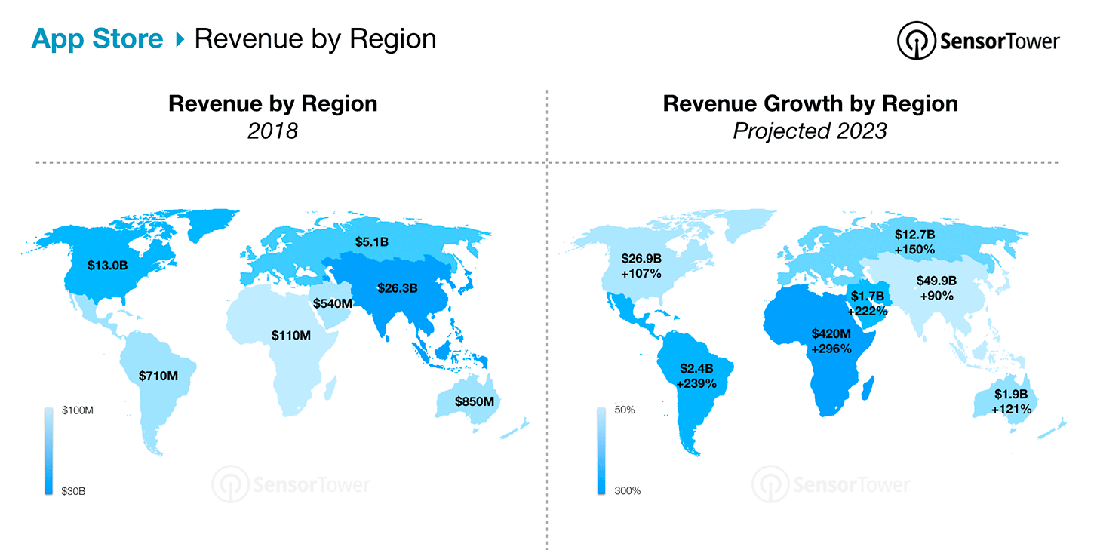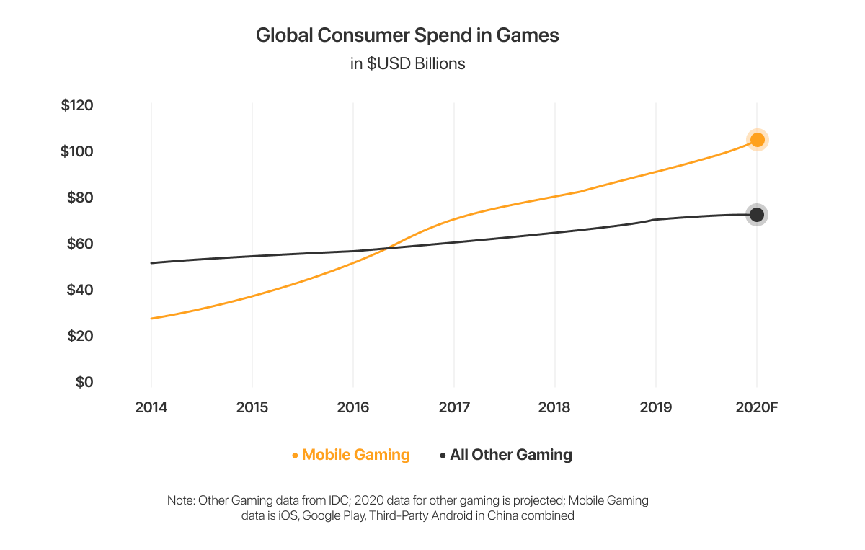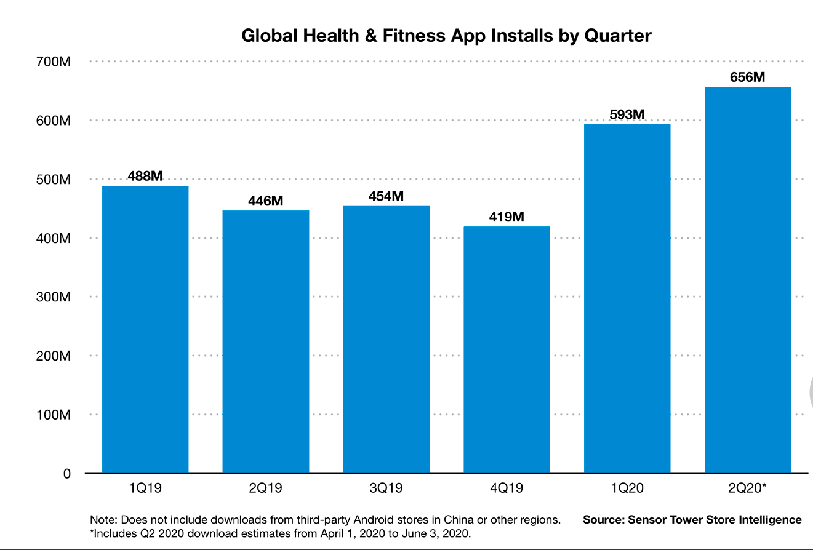How Much Money Can You Make From an App?

App Store and Google Play contain more than 4.8 million apps in total. Just imagine how much money these apps can potentially generate. But only a small amount of them really do, providing their developers with income of any kind.
The reason is a lot of variables one should consider when he lends up to developing an app for revenue. Also, it should be pointed out at the very beginning - if revenue is the only reason for creating an app, it would be better to be reconsidered.
Related: Evaluating Your Budget: How Much Does It Cost to Develop an App?
Yes, successful apps tempt developers to create something like that. But let’s be honest - it’s unlikely someone can create another Instagram or Uber. Prior to the app development, you should do a couple of things, and one of the most important ones is to focus not on the apps themselves, but on the features which make these apps popular.
The first and foremost you should do is to get a general idea of the app you are about to create, a general vision of it. As soon as you do, another question appears and the question is about the potential income you can get. The answer here is the only one - it depends. A niche, platform, monetization strategy - all these factors matter. Later on, we will discuss how the income depends on them.
Does the Income Depend on the Platform?
The platform does matter because marketing strategy depends on it as well. The potential purchases share also depends on the platform and its popularity. And it is important, because iOS takes about 27% of the world market, whereas Android takes almost 73%. But keep in mind that these statistics are irrelevant for the whole world in general. If you look at each region separately, the picture can be completely different.
To be more precise, just consider the fact that people in the USA, Canada, Australia, Japan, Great Britain, and Scandinavian countries prefer iOS while users from Eastern Europe, some Western European countries, South America, Africa, and most Asian countries tend to choose Android devices. It generally means that when you create an app, regional preferences become a matter of high importance. As the data regarding the App Store, provided by Sensor Tower, the most significant growth is to be expected in Africa, Latin America, and Europe. So if you are about to develop an app for iOS, consider these regions for your target areas.
When creating an app, these regional preferences are vital to the implementation of your monetization model.

App Store's Revenue by Region. Source: Sensor Tower

Google Play's Revenue by Region. Source: Sensor Tower
The figures above show that the Asian region is considered the one with the lowest overall app revenue growth.
But revenue predictions are just one of the sources of information. Another thing that should be considered is the user's purchasing power. Let’s take Android and Apple users. Surely, Apple users have more purchasing power than people using Android, spending 2 times much money in the app stores.
At the same time, before the stats are converted into money, they are just bare figures.
Based on the figures above, for both the iOS and Android apps, Asia is predicted to have the lowest overall app revenue growth. The most recent data illustrates that the overall income generated by mobile apps in the first half of 2021 is about $50.1 billion. Here iOS apps provide $32.8 billion, and Android apps take $17.3 billion. There’s a gap at the moment but according to the prognosis it is about to become smaller in time.

App Revenue Forecast, 2019-2024. Source: Sensor Tower
At the moment it might seem that Apple App Store loses to Google Play Market. But is the situation really as bad as it looks for the Android market? Consider another piece of information. In the first half of 2021 App Store’s app installs accounted for 18.3 billion, whereas there are 53.2 billion installs in Google Play. So people install more apps from Google Play In total.
To sum up, it can be stated that Apple can potentially provide you with more purchases and more users with huge purchasing power, whereas Google opens wider market coverage opportunities and a bigger amount of downloads.
The platform choice has to be done wisely because the revenue depends on it.
Monetization Models
Choosing a platform is important. But without choosing a monetization strategy you can’t get income from the app at all. There is good news for you - there's no need to reinvent the wheel, all the strategies are described already. There are millions of apps working at the moment, so humanity has collected tons of information about monetization models and how they can be implemented.
You can consider the success stories of different brands, having implemented this or that strategy before using it in your own project. As soon as you feel confident with these well-known and good-tested models, you can start exploring different approaches and try their combinations.
The models can be classified into three groups just to make them clearer:
- Free apps: As it becomes clear from the name, these apps have no paid content. Users Install them for free.
- Partially free apps (Freemium): The most popular model. Apps themselves are downloaded for free, but free functionality is limited. Users will have to pay and donate money if they want to enjoy the full functionality.
- Paid apps: such apps should be purchased before the user can download them. As a rule, the apps provide a free trial period for the users to get acquainted with it. As soon as this period is over, the user should pay the fee.
Now when we have made a brief overview of the payment methods, let’s take a closer look at the ways they can be used for earning money.
#1. Free Apps
One of the most common mistakes people do when thinking about free apps is that they don’t generate money. But they really do, so let’s have a look at how they are doing it. In two words, the answer is simple- in-app advertising, or affiliate marketing.
The app owner earns money from the interactions users perform with the ads, displayed in the app. But keep in mind that free apps provide good profit from ads only if there are a lot of downloads.
There are some affiliate marketing campaign types, for example:
- Cost per click (CPC): the app owner gets payment from every click. But in reality, there are a lot of factors that impact the final revenue and profit. Also, it’s important to keep in mind that the click on its own is nothing and the campaigns of this type use a cost per mille (thousand) calculating strategy.
- Cost per view (CPW): The more users watch the ad in the app, the more money you get. In this campaign, they use video ads.
- Cost per install (CPI): The app owner gets income when the users install the app which is displayed in the ad.
The options are different and one can always choose this or that. In the beginning, it is a wise decision to pick a format based on the criteria that bother you the most. However, this approach does have one drawback. You need to test and analyze ads all the time. This, in turn, leads to frequent placements and format changes.

Ad Formats in Mobile Applications
#2. Partially Free Apps (Freemium)
In case using ads in your app does not seem appealing, there’s an alternative - a so-called freemium model. Users like this model because they can enjoy the app and explore its content before paying anything.
Freemium means that users process in-app purchases and pay for some exclusive content or subscriptions with additional benefits. Gaming apps use this strategy a lot - they sell extra lives, additional content, or necessary items.
However, this strategy has some important disadvantages and if you are about to choose it, take a closer look at them. In two words, there’s a chance that users won’t be interested in extra content and will choose to explore only the content available for free.
The only way to cope with it is to provide users with the content of high value, so people will be ready to pay some extra to get it. It is called “converted loyalty” when loyal players and app users are converted into customers, willing to pay.
Another point is that you won’t get the exact amount you have set because Google and Apple stores have their own share. It is not that big, but still, the share is share. As a rule, the share is about 15-30% out of the sum the user pays. It means that you should find a balance between that amount you state for the extra content and the customers’ desire to pay for it.
#3. Paid Apps
They change their lot just once and as a rule, it is a downloading fee. When the user pays for the app, he gets all the sets of features at once. This way is the oldest and the most straightforward one. Earlier, when mobile app development just appeared, this strategy was the dominating one.
Nowadays, as the choice becomes much bigger, users prefer free and freemium apps to paid ones. This shift had a huge impact on the development in general, and in return, more and more newly created apps use these strategies from the very beginning.

Free and Paid App Distribution for Android and iOS. Source: Statista
Paid apps have a huge disadvantage - their revenue is linked to the new users who download the app. In case it’s ok for you to work on the user base so it is growing consistently - the paid apps might be a solution for you. But before you dig into setting the price, calculate all the pros and cons, to find the perfect balance.
Of course, you can have doubts regardless of the strategy you choose. In 2020 people spent $50.1 billion on Apple’s App Store and Google Play Stores, but the main source was not paid apps but in-app subscriptions.
What Mobile Apps Category Generates the Most Money?
After the COVID outbreak home quarantine measures had become the reason for a significant shift in the place mobile apps have in our life. Smartphones became the only source of communication not just with people around but with the outside world in general. And according to the statistics, the share mobile apps have in our lives will be growing in a couple of next years. Just think about it - people spent around a trillion hours in so-called “at-home” apps this year, and the limit has not been yet hit.
According to the App Store statistics, by 2024 it will be mobile apps, not games, to generate the most significant revenue. Subscription monetization is expected to become the main source of income, which will reach $58 billion on Apple’s App Store in 2024.

App Store Revenue Share by Category. Source: Sensor Tower
The place where game apps will be dominant for some time is Google Play. Thus the projected share is around 74% in 2024 compared to 49% on the App Store.

Google Play Revenue Share by Category. Source: Sensor Tower
Dating Apps
Dating apps will become even more popular, so the revenue that can potentially generate will rise accordingly. The amount consumers had spent in 2021 is doubled in comparison to the figures reported in 2020.

Global Consumer Spend in Dating Apps. Source: App Annie
In-app purchases are the strategy used for dating apps. It was and still is the most popular option for owners who want to monetize their dating apps. Let’s take Tinder. This app is famous enough to become a good example. Thus it generated $1.2 billion in both stores. These immense figures made Tinder the most lucrative non-gaming app. People can download it for free but the set of additional premium features on a subscription basis became the breaking point which turned just another app into one of the most successful cases in the industry.
And can you guess what app is the second-highest-grossing dating app? Yes, it’s Bubmle, the best competitor of Tinder. It is female-friendly and is centered around the women’s choice, as well as allows women to start the conversation first. This app is focused on serious relationships and provides profiles of better quality. It is also considered to be more secure in comparison to Tinder, thus its user base is smaller. And Bumble uses the same monetization strategy, being another good example of a success story.
Related: How to Make a Dating App Like Tinder?
If you think dating apps use the only monetization strategy, you are not completely right. MeetMe uses old good ads, so users can enjoy the features without paying for premium account options or dig into subscription modes. The app also offers an alternative to users, allowing them to choose between ads and video ads. If the user chooses video ads, he can boost his profile and get some additional features or content. If you are interested in figures, here they are - the app earns $3 million in revenue and 300K downloads per month.
Related: How You Can Make Money on a Dating App (With Live Examples)
Game Apps
The gaming industry is growing, making up 72% of all app stores spend. The figures clearly show that people started to put more money into gaming in recent years. But figures say louder than words, right? So, here they are - gamers spent $100 billion in 2020 and this figure is expected to rise up high by the end of 2021.

Global Consumer Spend in Games. Source: App Annie
Ok, we have calculated how much money the gaming apps generate. But how do they do it? The answer here is - by choosing the best matching monetization strategy, and the choice generally depends on the game genre. Let's take a hyper-casual game. They do not require a strong set of skills, so for games of this kind, in-app ads work best.
Paper.io implemented rewarding ads - when the customer watches an ad, he gets some extra life or additional content, not available otherwise. The estimated revenue of this app is $5K per month.
If the mobile game development services require a stronger set of skills and have higher engagement rates, in-app purchases work best, so this strategy is implemented as the main, but not the only one, source of income. Among the games, using this strategy, there are such huge apps as Tencent’s PUBG Mobile, which made about $1.3 billion in H1 2020, and Honor of Kings, which earned $1 billion.
These apps can be downloaded for free, but the only way to make real progress is to use in-app purchases, paying for the characters’ upgrade, extra items, content, required commodities, and so on. It doesn't seem that impressive, but let’s think about the fact that the audience of the game is about 100 million active users, and each of them pays this or that amount to succeed or get some item he requires.
Entertainment Apps
Home isolation changed a lot of our lives, it's a fact. And one of the changes is related to how people entertain nowadays. For example, instead of using cables consumers are shifting to streaming services for their entertainment needs. Let's be honest - cable TV losing to streaming services, which are distributing fast and provide highly personalized content. COVID-19 pandemic had an impact on entertainment, there’s no doubt about it. But along with restrictions it brought real prosperity and development to the streaming apps.
Another simple question for you - guess top-grossing entertainment app. The task is pretty simple - of course, it’s YouTube and TikTok. Being on the top of the game, they use different monetization strategies and still are winning, being the top of the niche.
YouTube has generated $431 million globally in H1 2020 and most of the content is still free. The success key is in-app ads and ad-free subscription modes. The price is decent, but with an audience of 2 billion users, it does its deed.
TikTok, on the contrary, uses a combination of ads and in-app purchases. In practice it means that users pay money to get co?ns, allowing them to send virtual gifts. This strategy brought TikTok $421 million in revenue at the beginning of 2021.
Another kind of apps, being extremely popular in the entertainment category, is video and audio streaming. Providing mostly free content, the apps like Netflix and Pandora offer users subscriptions and demonstrate ads, getting ~$30 million and ~$15 million per month accordingly.
Health and Fitness Apps
At-home fitness apps set a new record after the lockdown outbreak so the revenue growth was truly remarkable. Just one example for your interest - in Q2 2020, Peloton’s quarterly revenue grew 172% year over year. So the income was bigger than the expected ones almost 4 times. It is clear that the home fitness apps will continue growing and getting more and more profitable.
The growth of the home fitness app market is an expected and well-prognosed matter, because as the dynamics show, in 2021 and 2022 the companies will adopt remote work strategies and mobile habits will continue to change. The figures provided by Reports and Data clearly show that the expected growth of the mobile app market is expected to reach $14.64 billion by 2027

Global Health & Fitness App Installs. Source: Sensor Tower
Strava is one of the leaders in the industry, and the estimated amount people spend monthly is about $2 million. Calm is another example of a success story. This meditation app has $6 million in gross revenue per month. The apps work on a subscription model, so the users can unlock some additional features after the subscription plan is paid. The in-app purchases are also available in case of users decide to get some additional services related to meditation and healthcare.
Sweat is another example of what new developers can implement and what the audience really wants to get from the app. When the app was first released, its user base was really stunning. Now its revenue is estimated at $100 million yearly. The Bikini Body Guide (BBG) was created, so online fans slowly but steadily became paying customers with immense purchasing potential. The goal was simple and it was reached with the help of providing users with 28-minute workouts, yoga videos, and meal plans on a monthly or yearly basis. So yes, here they had used a subscription-based model as well, and it really wrecked out.
Educational Apps
But is it true that the rest of the app categories can’t generate substantial revenue? Well, not quite like that. Other categories can still generate a lot and educational apps are on the top of this list. They are not only the game changers nowadays, they can be the way for you to have a good impact.
Babbel is just one of the examples of lucrative language learning apps. It offers short lessons, crafted by native speakers and language experts. The app is focused on conversations, not on vocabulary or grammar. There are no in-app ads, just a subscription to get access to the additional content. So the users are not distracted from learning, getting 100% out of the app. Such a wise strategy resulted in $115 million in revenue per year.
Related: How to Build a Powerful eLearning App
There’s one fact worth mentioning and it lays on the surface - all top apps use subscription models. They actively encourage users to switch to Premium for new features and additional benefits. As it was mentioned, a strategy like that is the gold mine for apps, providing dynamic content to the users.
Is it Profitable to Develop Apps for Other Smart Devices?
Apps are implemented into smart devices and nowadays these apps-inside-apps are a common practice. The wearable technology market is growing, reaching $50 billion in revenue in 2019. These immense figures became real because of IoT spreading across the globe. The wellness and lifecare industries are the main areas where wearable devices are used at the moment. The reason is simple - they provide real-time access to the user]’s health condition and metrics, for example, data on blood pressure, glucose levels, quality and quantity of sleep, steps are taken.
There are a couple of segments in this market - eyewear, headwear, bodywear, wristwear, footwear, and other wear. It is predicted that eyewear and headwear will thrive in the next couple of years. So if this area sounds interesting to you, it’s a wise decision to have a closer look at these segments.
Smart TVs are another kind of smart device, whose popularity is constantly growing. It all works like that: the number of streaming services and users involved is growing, so the number of smart TVs and related apps is growing too. The Smart TV market is going to be worth $298 billion in 5 years, the reports say. Netflix, Hulu, and YouTube already have a huge user base and they are indeed used in Smart TVs. It’s absolutely clear that their revenue will be growing too.
Another point to consider is AI's rapid development and growth. Ai made such services as Alexa and Google Assistant real. They can do whatever you want them to, including reading aloud. So in 5 years, the smart speaker market can hit $35.5 billion in revenue.
All these facts show: apps are not tailored to smartphones only. They can be a part of absolutely anything, so keep in mind wearable devices if the segment seems appealing. Think outside of the box and get the best solution out of the list.
Key Takeaways
Now when you have coped with the whole article it’s time, to sum up - there’s no definite answer to how much money an app can generate. Still, there are statistics about different app categories and it will be the source you can use for your calculations. For example, when we talk about gaming apps their potential is close to becoming billion-dollar earners. Less complex apps and the smart device market have immense potential as well.
As it was stated in the researches we have used for this article, op apps use a subscription-based monetization strategy, combined with other sources of revenue. So do not forget about the world around you and the possibilities the world around provides.
The possibilities of making money with the mobile app you have developed are incredible. To develop a perfect monetization strategy one should conduct profound research on platform differences, monetization strategies, and their combinations, and other matters.
Our main mission is to help your business grow and prosper with our mobile app development expertise. Contact us to get a free consultation from our analytics so we can help you to choose the best niche, app type, and monetization strategy.